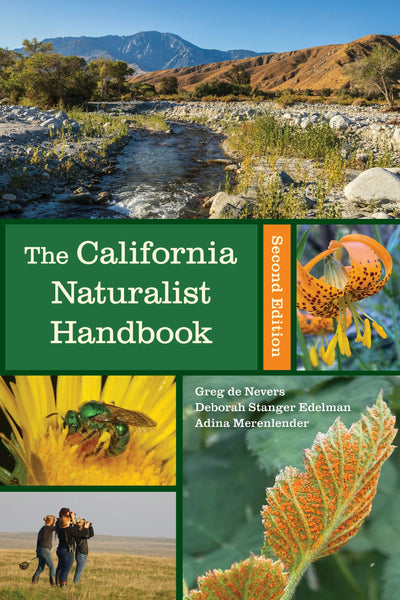You may also like
The California Naturalist Handbook, Second Edition
Regular price $34.95 Save $-34.95The go-to guide to California’s natural history, now updated with fresh insights on stewardship for a changing climate and diverse naturalist perspectives.
The California Naturalist Handbook offers a fun, science-based introduction to California’s natural history, emphasizing observation, discovery, communication, and stewardship. This accessible guidebook explores geology, native plants and animals, freshwater resources, forest and rangeland resources, conservation biology, and the effects of pressing environmental issues. Aspiring naturalists will learn how to keep a nature journal, practice participatory science, and improve ecosystem resilience.
Used statewide for the California Naturalist Program, this updated edition includes:
- Updated overview of California’s unique ecosystems and plant and animal communities
- Expanded discussions of Indigenous knowledge and stewardship
- Contributions by diverse naturalist leaders including women, Indigenous peoples, and naturalists of color
- A deeper dive into southern California’s urban and desert ecologies
- Current climate change information, including fire and forest management, drought, flooding and groundwater issues, and recognition of climate grief
- Higher quality images showing a more diverse range of habitats

Bay Area Wildlife
Regular price $35.00 Save $-35.00Learn about the wildlife of the Bay Area from a lifelong protector of endangered species, and enjoy the wild ride.
Jeff Miller's quirky guide to the coolest animal neighbors in the Bay Area will have you gawking at elk, whooping with cranes, and crowning yourself a crossing guard for newts before you know it. Join Jeff on a local safari to meet more than sixty species of mammals, birds, fish, reptiles, amphibians, and insects, and discover the fascinating and sometimes bizarre mating, feeding, and athletic antics of our most charismatic animals.
Portraits by Obi Kaufmann, the renowned conservationist artist who created The California Field Atlas, bring each animal to vivid life alongside fun facts, comical photos, and maps to help you scope out the best spots to find your furred, feathered, slimy, and slithery friends. Imbued with the author’s deep compassion for the well-being of our local fauna, Bay Area Wildlife reveals why each of these creatures matters, as well as the threats that loom over our region's incredible biodiversity.

The Deserts of California
Regular price $55.00 Save $-55.00A magnificent illustrated journey into California’s famed deserts and the astonishingly abundant life they contain.
2023 Glenn Goldman Award Winner for California Lifestyle, Chosen by the California Independent Booksellers Alliance
A San Francisco Chronicle Bestseller!
From Obi Kaufmann, author-illustrator of the best-selling California Field Atlas, comes a grand adventure through time, geography, and ecology in California’s deserts. Of a piece with his richly illustrated books The Forests of California and The Coasts of California, this volume features hundreds of vivid watercolor maps and illustrations, blending art and science to breathtaking effect. Journeying through the Great Basin, Mojave, Colorado, and Sonoran Deserts, Kaufmann pays special attention to national and state parks and monuments, and to the dozens of wilderness areas that reveal the underappreciated natural abundance of California’s arid lands.
From Joshua Tree to Death Valley, these deserts full of life, as Kaufmann evokes them, are perfect places for meditating on our future, and for imagining a California that might thrive beyond the age of climate breakdown. The Deserts of California is a canonical entry into the literature of the American deserts, uniquely colorful and celebratory, and abounding in hope and wonder.

The ABCs of California's Native Bees
Regular price $38.00 Save $-38.00"Krystle Hickman's travels across wild landscapes reveal rare and elusive pollinators, each one meticulously photographed and arranged in a brilliant A-to-Z tribute." —Olivia Messinger Carril, coauthor of The Bees in Your Backyard
National Geographic Explorer Krystle Hickman has spent a decade capturing exquisitely detailed photographs of native bees and making exciting discoveries about their behavior in the field. In her debut book of natural history, she offers an intimate look at the daily habits of rare and overlooked native bees in California: those cloaked in green or black or red, that live alone in the ground or sleep inside flowers, that invade nests and pillage resources like infinitesimal conquerors, or that, unlike more generalist honeybees, are devoted exclusively to the pollen of a single type of flower. A committed conservationist and community scientist who knows all too well how precarious the wellbeing of these insects is, Hickman shares her adventures in local native plant gardens and throughout the far reaches of California to bring the beauty of such diverse ecosystems into wondrous bee's-eye view. Meant for all curious readers, this collection of bee stories—one for each letter of the alphabet, matching the first letter of a bee's scientific name—will leave you both wowed and compelled to help save these fascinating beings and the lands they call home.

Butterflies of the Bay Area and (Slightly) Beyond
Regular price $50.00 Save $-50.00An illustrated obsession, a guidebook, a kaleidoscope of life on the wing.
"If you live in the Bay Area and wish to know the butterflies, this is the only field guide you'll ever need." —Lewis Hyde, author of The Gift
Liam O'Brien has spent three decades chasing, learning about, protecting, occasionally catching, and always loving butterflies. Here, he shares his capacious knowledge of California butterflies through a treasure trove of stories and 700 gorgeous, hand-drawn illustrations—featuring both adult forms and caterpillars—of the 135 species that live in the greater Bay Area. This sumptuous book also shares practical tips for finding and identifying all the butterflies who call the Bay Area home. Learn which plants nurture Silver-spotted Skippers, which trail to hike to see Swallowtails flitting creek-side, and why so many butterflies cluster on hilltops. Share in the joy that O'Brien brings to the study of butterflies, and join the community scientists contributing to our understanding of Monarchs, Metalmarks, and Marbles—and what they need to survive and thrive in our busy Bay Area.

Flowering Plants of the Sierra Nevada
Regular price $65.00 Save $-65.00The most extensive guide to identifying the flowering plants in California's richly diverse Sierra Nevada mountains.
This photographic guide to the wildflowers of the Sierra Nevada has been over twenty-five years in the making, drawing together spectacular images by Stephen Sharnoff, the photographer of the acclaimed Lichens of North America, and informative text by botanist Joanna Clines, who has decades of field experience and is a top authority on the region's flowers. Comprehensive and deeply researched, it will help users identify 1,000 flowers found in California’s iconic mountain range, from our celebrated manzanitas and lovely lupines to tiny California popcorn flowers. The book's detail will satisfy die-hard plant experts, while helpfully annotated photographs—pointing to fruits, anatomical features, and color variations—will guide beginners to botanizing.
The geographic range stretches from the western foothills through the alpine zone, and down to about 6,000 feet on the eastern slope; and from Lake Almanor in the north to the Tehachapi Mountains.







